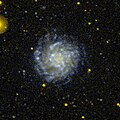NGC 5668
| Galaxy NGC 5668 |
|
|---|---|

|
|
| SDSS recording | |
| AladinLite | |
| Constellation | Virgin |
|
Position equinox : J2000.0 , epoch : J2000.0 |
|
| Right ascension | 14 h 33 m 24.3 s |
| declination | + 04 ° 27 ′ 02 ″ |
| Appearance | |
| Morphological type | SA (s) d |
| Brightness (visual) | 11.6 mag |
| Brightness (B-band) | 12.2 mag |
| Angular expansion | 3.0 ′ × 3.0 ′ |
| Surface brightness | 13.8 mag / arcmin² |
| Physical data | |
| Affiliation | LGG 386 |
| Redshift | 0.005260 +/- 0.000003 |
| Radial velocity | 1577 +/- 1 km / s |
|
Stroke distance v rad / H 0 |
(70 ± 5) · 10 6 ly (21.6 ± 1.5) Mpc |
| history | |
| discovery | Wilhelm Herschel |
| Discovery date | April 29, 1786 |
| Catalog names | |
| NGC 5668 • UGC 9363 • PGC 52018 • CGCG 047-090 • MCG + 01-37-28 • IRAS 14309 + 0440 • 2MASX J14332469 + 0427223 • GC 3926 • H II 574 • h 1835 • | |
NGC 5668 is a 11.6 likes bright spiral galaxy of Hubble type SD in the constellation Virgo , the estimated 70 million light-years from the Milky Way 's center. The supernovae SN 1952G , SN 1954B and SN 2004G4 were observed in the galaxy .
The object was discovered on April 29, 1786 by Wilhelm Herschel with an 18.7-inch reflector telescope, who described it as "F, S, LE, resolvable, preceding 2 very considerably small stars".
Ultraviolet recording using GALEX

